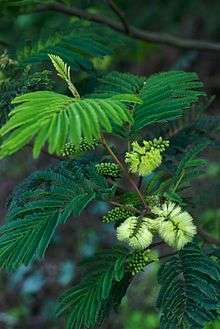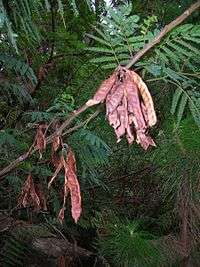Paraserianthes lophantha
| Paraserianthes lophantha | |
|---|---|
 | |
| Scientific classification | |
| Kingdom: | Plantae |
| (unranked): | Angiosperms |
| (unranked): | Eudicots |
| (unranked): | Rosids |
| Order: | Fabales |
| Family: | Fabaceae |
| Subfamily: | Mimosoideae |
| Genus: | Paraserianthes |
| Species: | P. lophantha |
| Binomial name | |
| Paraserianthes lophantha (Willd.) I. C. Nielson | |
| Synonyms | |
|
Albizia lophantha | |
Paraserianthes lophantha, commonly called Albizia, Cape Leeuwin Wattle, Cape Wattle, Crested Wattle or plume albizia, is a fast-growing wattle tree that occurs naturally along the southwest coast of Western Australia, from Fremantle to King George Sound.[1] It was first spread beyond southwest Australia by Baron Ferdinand von Mueller, who gave packets of P. lophantha seeds to early explorers under the assumption that if they planted the seeds at their campsites, the trees would indicate the routes they travelled.[2]
It is considered a weed in the parts of Australia where it is not indigenous,[3] as well as in New Zealand, South Africa, the Canary Islands, and Chile.

Seed pods
See also
References
- ↑ "Paraserianthes lophantha (synonym Albizia lophantha)". 2003-12-16. Retrieved 2008-09-28.
- ↑ http://www.weeds.org.au/cgi-bin/weedident.cgi?tpl=plant.tpl&ibra=all&card=E10#
- ↑ "Weed of the month archive". Angair Inc. Retrieved 2013-08-27.
Further reading
- Randall, Roderick Peter (2002). A Global Compendium of Weeds. Melbourne: R. G. & F. J. Richardson. ISBN 0-9587439-8-3.
- Blood, Kate (2001). Environmental Weeds: A Field Guide for SE Australia. Mount Waverley, Victoria: C. H. Jerram & Associates. ISBN 0-9579086-0-1.
This article is issued from Wikipedia - version of the 12/27/2015. The text is available under the Creative Commons Attribution/Share Alike but additional terms may apply for the media files.